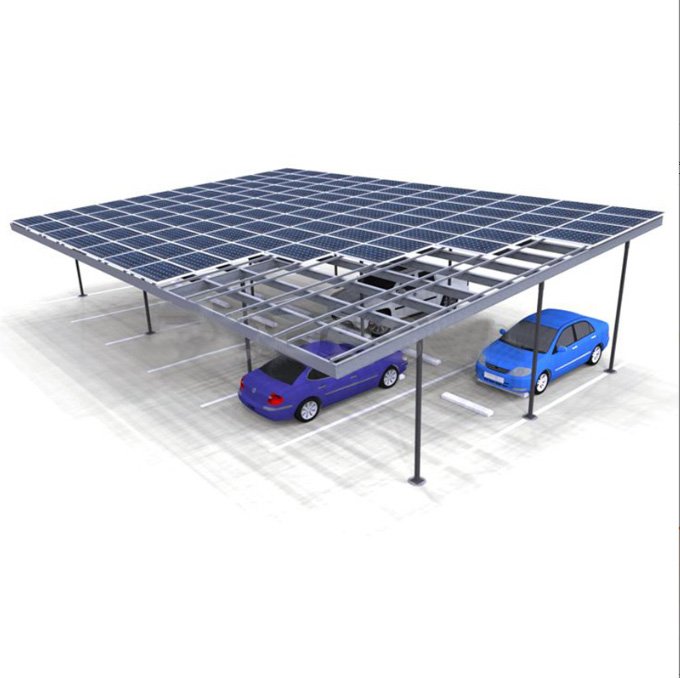Solar Carport Definition and Core Functions
A solar carport is a multifunctional facility that integrates parking protection with photovoltaic power generation. Its core functions include two aspects: providing a sheltered space for vehicles (cars, motorcycles, bicycles, etc.) to protect them from wind and rain, and converting sunlight into electricity through photovoltaic components installed on the roof, achieving self-sufficiency in energy and grid revenue (). Compared with traditional carports, it has both environmental friendliness and economic benefits, and can be regarded as a “high-tech garage” that not only meets basic parking needs but also serves as a carrier for distributed photovoltaic power stations, electric vehicle charging stations, and other composite scenarios ().
Classification of Solar Carport Structures and Design Features
Classification by Structure Form and Installation Method
- Stand-alone and Building-connected: Stand-alone models do not need to rely on buildings and are suitable for open spaces or parking lots; building-connected models are directly installed next to residential or office buildings, saving space ().
- Differences in Foundation Structure: Using point foundation design, which is lighter than traditional garage line/surface foundations, has lower fire requirements, and simpler construction approval procedures ().
- Roof Shape and Component Selection: Common roof shapes include flat and sloping roofs. Ordinary photovoltaic components (low cost, short payback period) or double-glass components (strong aesthetic appeal, good transparency) can be used. Some designs use semi-transparent solar modules to balance lighting and power generation ().

Solar Carport
Typical Structure Components
| Structure Part | Function and Material |
| Supporting Frame | Often using portal steel structures with steel columns and C-shaped steel beams. Some cases use finger-jointed solid wood or high-strength aluminum alloy to ensure wind load resistance (). |
| Photovoltaic Component System | Includes photovoltaic panels, brackets, inverters, etc. Existing carport roofs can be modified or integrated directly into new carports. Supports plug-and-play DIY installation kits (). |
| Additional Function Modules | Can be equipped with charging piles, sensor systems (such as intelligent parking guidance) to achieve a “parking-generation-charging” loop (). |
Core Advantages and Application Scenarios of Solar Carports
Main Advantages
- Energy and Economic Benefits: A 5kWp system generates about 4200-4500 kWh of electricity per year, meeting part of the electricity needs of families or enterprises. Excess electricity can be sold to the grid. Compared with traditional garages, the structure is lightweight, and the construction cost is lower ().
- Space Efficient Utilization: No additional land is needed for photovoltaic installation, especially suitable for urban or factory area parking lot transformation, improving land utilization ().
- Environmental Sustainability: Reduces conventional energy consumption and carbon emissions, in line with green building and new energy policy orientation ().
Typical Application Scenarios
- Civil Sector: Family residences, community parking lots, equipped with electric vehicle charging piles, to achieve “self-generation and self-use” ().
- Commercial and Industrial Sectors: Enterprise parks, shopping mall parking lots, large-scale deployment can meet the power needs of the park, such as a Nanjing case certified as the “world’s largest photovoltaic building integration power station” ().
- Innovative Cases: Mobile photovoltaic carports, low-cost projects using existing wall structures for transformation, and landscape carports made of double-glass components ().
Cost, Return on Investment, and Construction Considerations
Cost and Investment Return
- Initial Cost: Including the structure of the carport and the photovoltaic system, the total cost is about 15,000-25,000 euros (the reference price in China needs to be adjusted according to the scale), and the unit price of the photovoltaic system is about 2000 euros/kW ().
- Return Period: Depending on the generated electricity, electricity price policy, and subsidies, the investment can usually be recovered within 5-10 years. Commercial projects have shorter payback periods due to economies of scale ().
Construction and Usage Considerations
- Regulatory Requirements: Need to apply for planning permission in advance to avoid being classified as illegal buildings due to “unauthorized construction”, affecting demolition compensation ().
- Component Selection and Maintenance: Choose the appropriate component power and installation angle according to the local illumination conditions. Regular cleaning of photovoltaic panels ensures efficient power generation ().
- System Stability: It is recommended to operate in parallel with the grid to cope with the instability of solar resources and reduce the pressure of battery costs ().
Industry Development Status and Trends
Market Dynamics
- Domestic and International Popularity: Widely used abroad and rapidly promoted domestically. Policy support for distributed photovoltaics and new energy vehicle supporting facilities construction ().
- Technological Innovation Directions: Intelligentization (such as PV tracking systems, IoT monitoring), component upgrades (high-efficiency semi-transparent modules, double-glass components), and lightweight structural design are key research areas ().
Case Study References
- Large-scale Projects: A Nanjing PV carport was certified as the “world’s largest photovoltaic building integration power station” by Guinness, using tracking systems to increase power generation ().
- Low-cost Retrofitting Cases: Using existing wall structures to build PV carports reduces foundation construction costs, suitable for small and medium-sized enterprises or community retrofitting ().
Solar carports, as innovative combinations of “parking + photovoltaics,” are evolving from single-function facilities to multi-scene energy nodes. In the future, they are expected to play a more important role in smart transportation, microgrids, and other fields.
